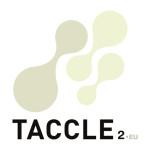This morning I had my come-uppence. Having watched my borrowed 3-4 year olds sail through the first and second ‘programming’ lessons with enthusiasm and take the ‘if..then’ and ‘not’ symbols in their stride, I tried to introduce a third symbol – the upside down V for ‘and’. They looked at me as if I had grown horns and despite building it up in tiny steps, exactly as in the previous lessons, it was actually a step too far! One small person picked up the ‘and’ card, thrust it in my face and said “I don’t want THAT one.”
However, 5 year old Dylan managed it perfectly well and 8 year old Ffion thought it was boringly simple – from which, I shall conclude that this exercise is definitely one for 4 to 6 yr olds.
We are assuming that children are now familiar with the syntax “If this..then this” and “If this…then not this“. The next important concept is to understand that sometimes you want to specify that more than one condition or variable is present in order to achieve a third condition or outcome. In other words, “If this AND this, then this”.
We started off by using “If you put your aprons on AND put newspaper on the table, then you can paint.” So far so good. They understood the syntax and they got to paint.
We talked a lot about their day-to-day experiences using similar logical constructions such as:
“If you eat your dinner AND your pudding then you can have sweets”
“If you put your pyjamas on AND get into bed, then you can have a story.” etc.

More interestingly for 5 year olds, we talked about rainbows as they had recently been learning about how they were formed. As a result we got..
“If sun AND rain, then rainbows”
We used the upside-down V as the symbol. This is in common use in maths and in programming. The option is to use a dot, which is also used in programming to denote ‘and’. However, in maths it can also be used for multiplication or decimal place so the potential for confusion is very high – don’t go there! What we would also say, is avoid the + symbol which is sometimes used by programmers. Children will be using + in maths to represent addition – which is a rather different meaning of ‘and’. In programming or logic, ‘and’ does not imply that we are adding two things together, rather that two conditions are present. A subtle difference but an important one.
In the middle of this activity, children spontaneously introduced negatives and multiple conditions as in “If you put your pyjamas on but you don’t clean your teeth and get into bed then you can’t have a story.” *thinks* tackle this next!!




 English
English Nederlands
Nederlands Deutsch
Deutsch Italiano
Italiano Español
Español Português
Português Română
Română Cymraeg
Cymraeg
Older pupils could use cards that represent reversible and non-reversible changes to materials in order to create formulae e.g. If wood AND flame then (not reversible symbol) e.g. [X] or If water AND HEAT then (reversible symbol) e.g. [!]